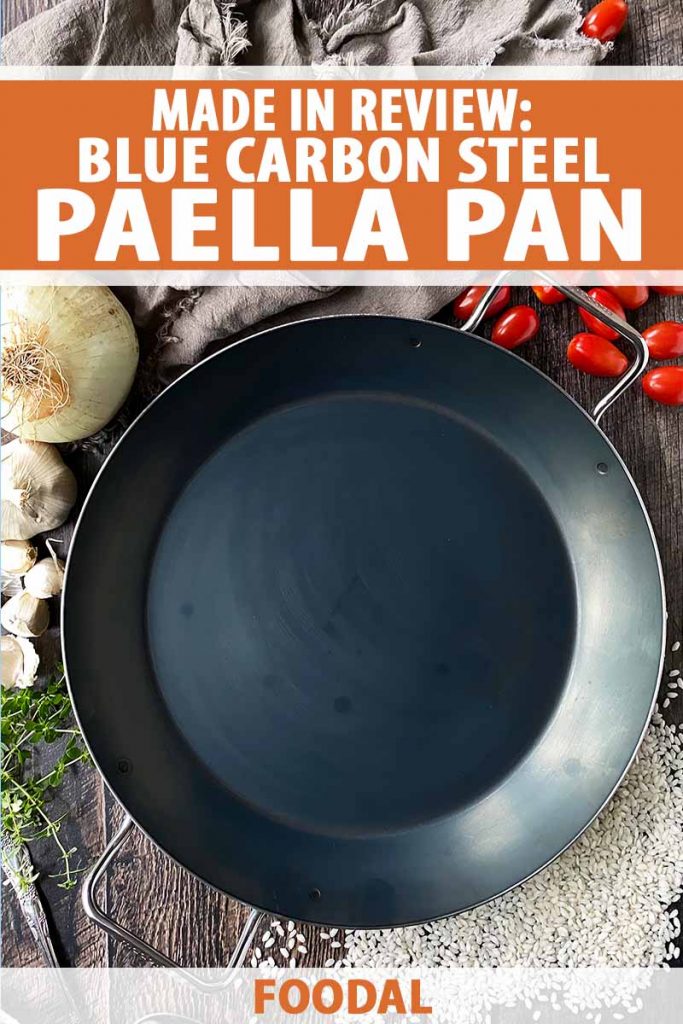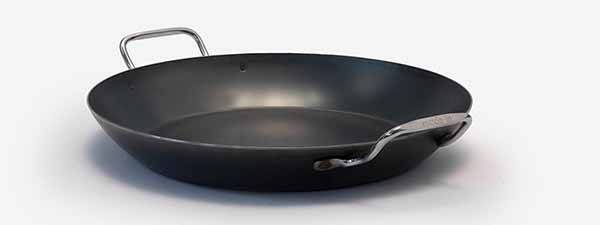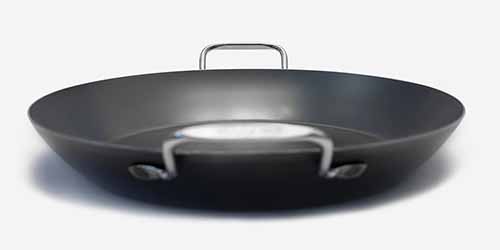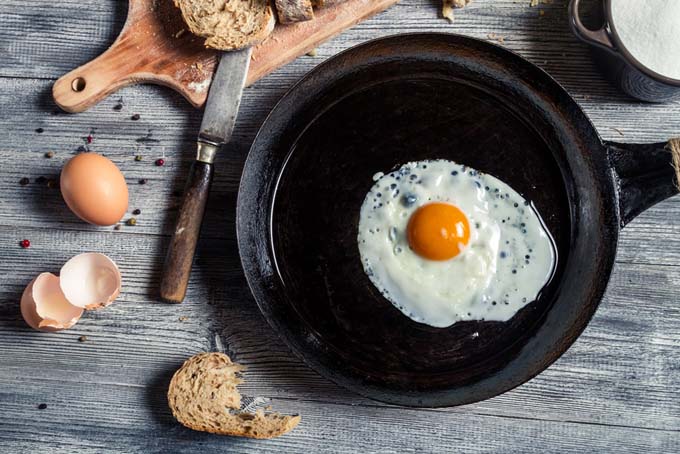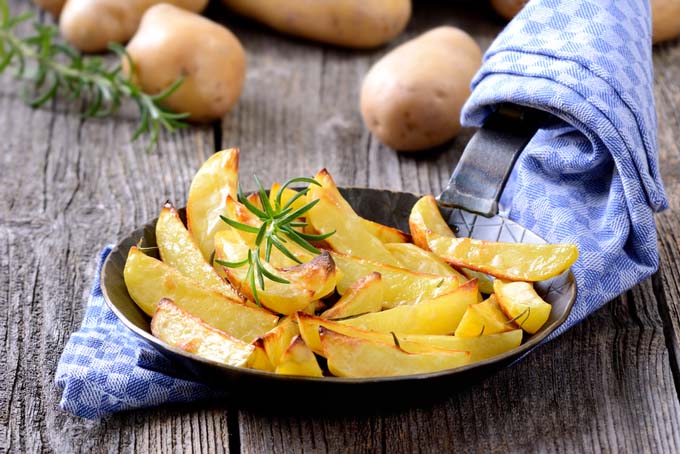Paella night can be a very special dinner occasion, and you’ll need the right pan for the most beautiful results!
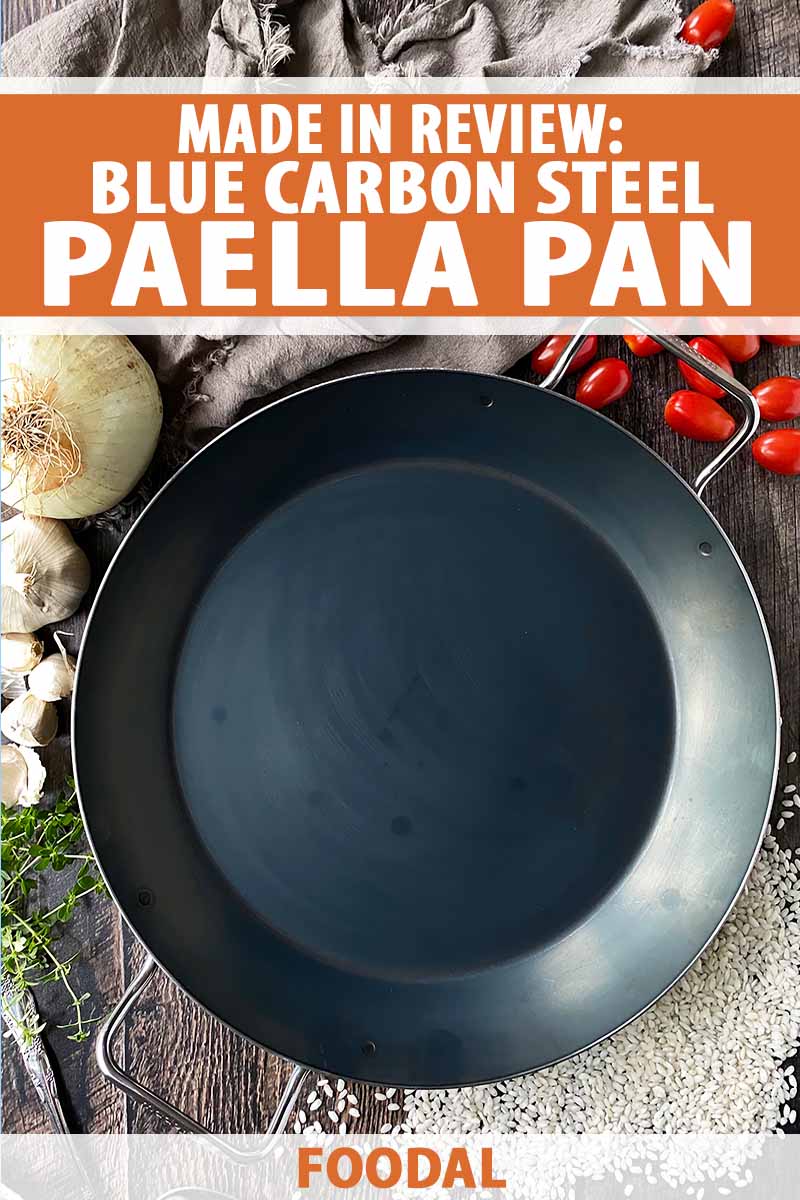
Consider purchasing Made In’s Blue Carbon Steel Paella Pan for your next jaw-dropping dinner.
Paella is an iconic national dish of Spain, with gorgeous colors and many variations highlighting the rice, produce, meats, and seafood indicative of the regional offerings.
We can do our best to replicate this breathtaking dish by making it in our own homes with the freshest of ingredients and the best cookware.
A paella pan’s wide and shallow shape is designed like that for the very specific task of maximizing the surface area – this intensifies and accelerates liquid evaporation from the rice to create the socarrat, the crispy, golden-brown crust of rice on the bottom.
You can read about all of our top-choice recommendations for paella pans in our roundup.
Right now, though, we’re featuring Made In’s Blue Carbon Steel Paella Pan here in more detail.
Continue reading to learn about the specifications of this cookware, its blue carbon steel material, cooking and cleaning tips, and more.
And let’s plan for a paella night soon!
Made In’s Blue Carbon Steel Paella Pan
The Specs
Made In’s Blue Carbon Steel Paella Pan is made in France. Withstanding temperatures of up to 1200°F, it is compatible with open-flame, oven, and stovetop cooking. It can be used on gas stoves, as well as induction burners.
Blue Carbon Steel Paella Pan, available from Made In
It weighs 4.38 pounds, so it’s heavier than many of the paella pans we’ve reviewed. The heaviness of the cookware augments its versatility for not just paella dishes, but also for roasting or baking whole birds and larger cuts of meats.
A heavier weight uniformly distributed throughout the bottom of the pan also avoids the risk of hot spots that may heat food unevenly.
With two handles on either side, measuring about 1/2 inch thick on top and a little over 1/4 inch thick on the sides, you can really feel how sturdy it is when you’re holding it and transferring it around the kitchen and to the table.
Its total diameter is 13.5 inches, and it has a smaller cooking surface diameter of 10 inches by 10.25 inches. The entire length including the handles is 17 inches.
The height with the handles included is 2.5 inches. And the pan’s depth is 1.4 inches.
Blue Carbon Steel
Made In’s carbon steel cookware is a silver-hued alloy of 99% iron and 1% carbon, with a 2 millimeter thickness.

The blue hue is not a coating. Rather, the blue coloring forms after the annealing process during manufacturing, when a thin layer of vegetable oil is applied to the surface of the steel and then baked at high heat. The process darkens the metal, which develops a blue color.
Annealing protects all of Made In’s blue carbon steel products from oxidizing, boosting their durability, and also helping with seasoning the cookware.
What makes blue carbon steel a better choice for you than, say, cast iron? There are some significant differences between the two materials.
While blue carbon steel and cast iron both share the quality of building seasoning over time, there are a few benefits to choosing a carbon steel pan over cast iron.
The smaller pores of carbon steel, compared to the deeper pores on cast iron cooking equipment, create a very smooth, slick, and even surface that is stick-resistant – as long as it is well maintained via the process of seasoning.
This finer surface texture also takes to the seasoning much faster than cast iron, and won’t be as sensitive (but not totally immune, mind you!) to rust.
Without sacrificing durability, blue carbon steel is also more lightweight, and heats up faster than cast iron.
Appearance Isn’t Everything
Admire the gorgeous midnight blue hue as long as you can – it won’t last!

Although the Made In Paella Pan’s blue hue is a beautiful sight to behold upon receiving, this color will indeed change the more you continue to cook with it.
Even before cooking, you might notice some small scratches, scuffs, or lines that resemble stretch marks. Made In emphasizes that these are not signs of serious damage, but just superficial markings in the vegetable oil from the annealing process.
You can see the markings clearly on the one that I received – there are a few splotches and long stretch mark lines.
As you cook and re-season your pan, the colors will fade, darken, and morph into many different colors and hues. This will continually change as you introduce oils, fats, acidic ingredients, and varying heat temperatures.
Just as I explained with Made In’s Blue Carbon Steel Wok, the color-changing process is normal with this kind of material, and is purely aesthetic. It will not negatively impact the functionality of the pan, as long as you use, clean, and care for it properly.
Your top priority with the longevity of the pan is not to obsess over its color, but rather, to focus on how you maintain it.
More on that in the next couple of sections, so keep reading!
Cooking Tips
You’ll be able to easily incorporate Made In’s Blue Carbon Steel Paella Pan into your cooking routines – whether you’re cooking vegetables on the grill, making a meal over the fire while camping, or creating the perfect paella.
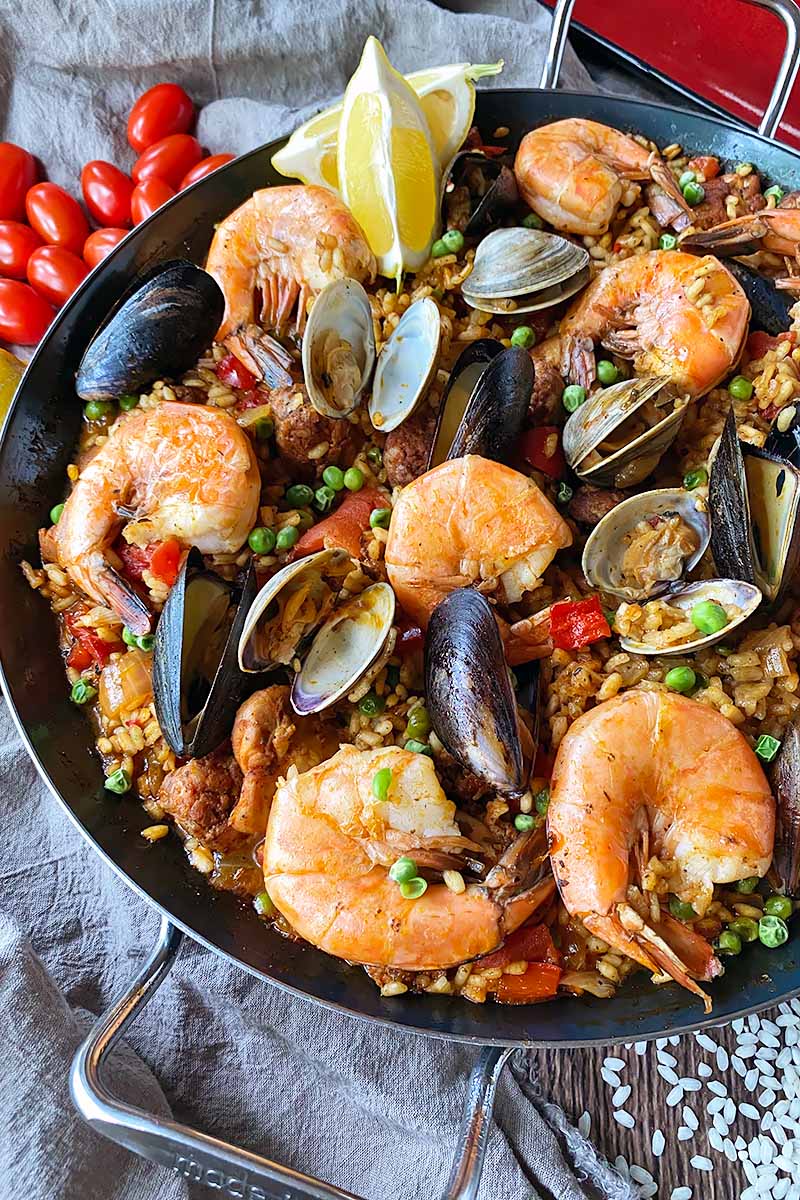
But there are some important pieces of advice for you to follow before the heat hits the pan!
Tip #1: Seasoning Is Not Just for Spices
Is your cookware properly seasoned? This particular item, as well as any other piece of blue carbon steel cookware, needs to be regularly maintained through the process of seasoning.
By treating the surface of the pan with oil and heating it, this helps to create a smooth surface for cooking as it coats over and protects the small pores.
Because the pores are protected from the invasion of water, seasoning also helps to prevent rust from forming.
This is a step that needs to be repeated after each use to continue building the strength of the seasoned surface, and to keep it as nonstick as possible so your food cooks flawlessly.
Tip #2: Save the Delicate Foods for Later
Made In recommends waiting to cook more delicate food items (like flaky fish and eggs) until you’ve had a chance to cook and season your pan after a few rounds of use.
A newer pan that only has one initial seasoning may cause more delicate ingredients to stick, and may also result in uneven cooking.
In order to develop your seasoned surface, cook with it as often as you can.
First, introduce your pan to higher-fat ingredients like red meats or sturdier food items like shell-on seafood and vegetables.
Tip #3: Be Careful with Acidic Ingredients
Acidic ingredients like citrus, wine, tomatoes, and vinegar are strong enough to strip away the pan’s protective seasoning.
While Made In warns its customers to avoid acidic ingredients if possible, many paella recipes would lose their deep flavor base without a splash or two of wine, or an offering of ripe tomatoes bursting with juice!
The company does note that cooking with acidic foods will not ruin the integrity of the pan, as long as you treat it appropriately afterwards.
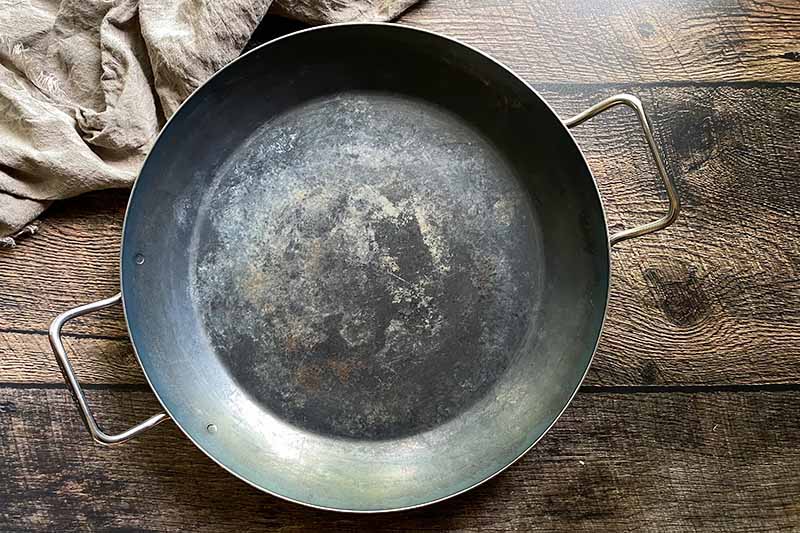
Whenever you do cook with these ingredients, it is imperative that you season your pan to rebuild the protective layer!
Looking for more information on cooking with carbon steel? Made In provides a complete and comprehensive guide on their website.
With this guide, you’ll find thorough information on cooking with this type of material, as well as how to care and clean for items made with it.
If you’re interested in learning more about caring and cleaning right now, keep on reading for our own brief overview of the best maintenance practices.
Tip #4: Consider the Amount of Food
With its 10-inch cooking diameter, the Made In Paella Pan can easily be used on your stovetop – it’s what makes it such a great option for the home kitchen!
However, the smaller size also puts the cook at risk of overfilling the pan with too many ingredients.
You must be careful to not overfill it with an excessive amount of ingredients. Pay particular attention to the amount of rice used when making paella.
The rice needs plenty of space to cook evenly in the liquid. If there is too much rice, the grains won’t be able to properly absorb the liquid.
This will lead to a snowball effect of problems:
The grains won’t cook properly, and will be underdone, forcing you to cook for far longer than anticipated. This leads to all of the other delicate seafood ingredients at a risk of being overcooked, and may also lead to a severely burnt, if not totally blackened, crust on the bottom.
Also, if there is too much rice, the meat and seafood you are cooking will also be overcrowded and won’t cook evenly.
In order to avoid this anxiety-ridden cooking failure, I am advising you now, as sternly as I can express via text, to use a recipe that calls for no more than 1 1/2 cups of rice (though 1 cup of rice would be ideal).
1 1/2 cups would be the absolute maximum amount for this particular pan. You will still be able to serve about 4 to 6 people with this amount, depending on portion size.
Care and Cleaning
Any carbon steel piece of cookware undeniably needs more TLC than a quick dip in some soapy water and air-drying after each use!
Blue Carbon Steel Paella Pan, available from Made In
The only time that it is 100% acceptable to use soap and water is when you first receive the pan.
This initial cleaning is essential to get rid of any excess oil or debris that may have accumulated during the packaging and shipment process.
Once you have done the preliminary cleaning, make sure you dry it thoroughly before beginning the initial seasoning process when you’re ready to cook for the first time with it.
Your most important responsibility as you’re cleaning this cookware is to maintain the seasoned surface. The safest and most simple way is to wipe out any excess oil that may be left over after cooking, exfoliate with coarse salt to remove food residue, wipe again, and re-season.
Seasoning your carbon steel pan after each use will perpetually build a slick, protective barrier.
For seasoning, you can choose to use a high-smoke point oil or Made In’s Seasoning Wax, available to purchase on their website.
If you have to apply water in order to clean any difficult stuck-on food residue, you’ll need to thoroughly dry off the pan to remove any moisture – if there is any residual moisture left over, this may cause rust.
And I don’t think you’ll be surprised when I tell you to never, ever, ever clean it in the dishwasher. No shocker here – the dishwasher can excessively strip the seasoning.
Warranty and Returns
All Made In products are covered for any manufacturer’s defects. Specifically for Made In’s blue carbon steel products, there is a lifetime warranty that covers defects that can impact the use or longevity of the cookware.
As stated above, “scratches” or “stretch marks” may not be actual damage, but just the coating of the vegetable oil on the surface of the pan. These are superficial, and will not impact the cookware’s performance.
The specific item comes with a 45-day risk-free trial beginning on the original delivery date. You can request a full refund, store credit, or exchange if you’re not completely satisfied. Within the first 45 days of delivery, returns are free for purchases made within the contiguous United States.
Read more about Made In’s returns and exchange policy, as well as the company’s warranty policy.
A Perfect Choice – If You’re Ready for the Upkeep!
Look, you don’t need to roll your eyes at me. I get it.
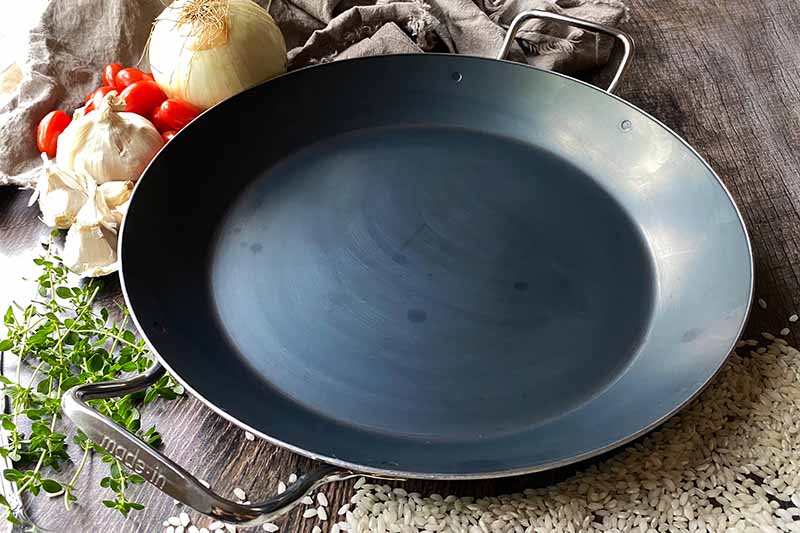
Caring for ANY blue carbon steel cookware, let alone Made In’s Blue Carbon Steel Paella Pan, can be a painstaking process!
But once you develop the habit of cooking, cleaning, and seasoning, it becomes part of a normal (and not annoying) routine.
And if you are willing and ready to put in the time and effort required for this type of material, you’ll be rewarded with some amazing benefits:
You’ll love how the weight of it makes it feel strong and sturdy, while still being light enough that it’s easy to pick up and carry from the stove to the dining room table.
You’ll get all the evenly heated, nonstick surface advantages of a cast iron skillet, but at a much faster speed.
And, based on my own paella-making experience in this pan, your paella recipe is going to turn out amazing results.
Have you been searching for a paella pan online? What do you think of blue carbon steel? Leave us a comment below!
If you like this product, consider buying other items from the Made In company! Check out their other lines we’ve reviewed next:
Photos by Nikki Cervone, © Ask the Experts, LLC. ALL RIGHTS RESERVED. See our TOS for more details. Product photos via Made In. Sample product provided by the manufacturer.
Nutritional information derived from a database of known generic and branded foods and ingredients and was not compiled by a registered dietitian or submitted for lab testing. It should be viewed as an approximation.
About Nikki Cervone
Nikki Cervone is an ACS Certified Cheese Professional and cheesemonger living in Pittsburgh. Nikki holds an AAS in baking/pastry from Westmoreland County Community College, a BA in Communications from Duquesne University, and an MLA in Gastronomy from Boston University. When she's not nibbling on her favorite cheeses or testing a batch of cupcakes, Nikki enjoys a healthy dose of yoga, wine, hiking, singing in the shower, and chocolate. Lots of chocolate.

